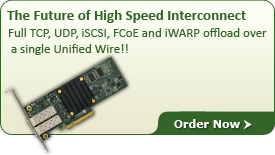 |
Terminator Features
|
Traffic Management capabilities of Chelsio 1/10/25/40/50/100GbE Unified Wire adapters can shape both receive and transmit traffic using sophisticated queuing and scheduling algorithms built-in to the ASIC hardware which provide fine-grained software control over different attributes to manage network traffic latency and bandwidth parameters such as packet rate and byte rate. Chelsio Traffic Management and QoS solution is designed and optimized to deliver following three main goals:
- Guarantee low latency in the presence of other traffic
- Control maximum bandwidth that a connection or a flow (a group of connections) can use
- Allocate available bandwidth to several connections or flows based on desired levels of performance
Chelsio hardware based Traffic Management and QoS solution’s core architecture is developed around the network traffic Pacing, Shaping, and Prioritization functions, focusing on bandwidth provisioning and QoS for host servers, virtualized servers, and tunneled network traffic across the VMs/VNFs. All functions are tightly integrated to enable following capabilities:
 |
| Figure 1 – Chelsio TM Solution |
- Low latency service alongside and simultaneously with the high bandwidth networking operation
- Controllable sharing of bandwidth among a number of traffic classes
- Sufficient number of classes to allow the individual traffic management of different VMs and VNFs within a virtual server
- Programmable and controllable rate shaping on a per-connection basis, regardless of whether there is one or thousands of active connections
- Allow the mapping of traffic to different classes of service to be at the finest granularity possible and under full software control
Chelsio Traffic management and QoS solution is capable to manage offloaded traffic including iSCSI, iWARP RDMA, DDP and non-offloaded (tunneled) NIC traffic simultaneously. Using the hardware traffic shaping capabilities, Chelsio adapters can support up to 16 QoS service or Traffic classes, each class serviced with a pre-configured data rate (either packet-rate or bit-rate). Each class can independently be configured to provide per-connection packet rate shaping, and additionally aggregate per-class packet rate shaping. It is possible to change the configured rate at any time and as long as the sum of the data rate for all classes does not exceed the link rate, the data rate configured for each class is guaranteed.
The benefits of these Traffic management and QoS mechanisms are manifold. The service differentiation aspects can be utilized in the context of a differentiated services network. In addition, rate control is beneficial for TCP performance in a heterogeneous network, where it can be used for instance to match the sending speed of a fast sender to the receiving capability of its clients, thereby avoiding costly packet loss. Per-connection rate shaping can be used in streaming (e.g., video) applications to match the rate of the media stream, or in the context of a server (e.g. Web) to limit the transfer rate to the clients.
 |
| Figure 2 – Chelsio Traffic Manager |
The offload transmit traffic shaping is based on applied specific data attributes, like input and output port, destination IP address, etc. The user can determine the action to be taken by the NIC, which includes dropping the packet, routing the packet to a particular port to be sent back out, or passing the packet onto the host. All of the above actions are done at line rate using 1/10/25/40/50/100Gb Ethernet Unified Wire adapters.
|